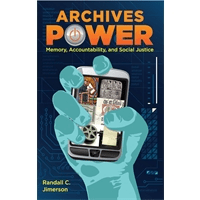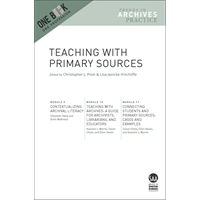
This post was authored by guest contributor Vince Lee, Archivist at the University of Houston, and current member of SAA’s Committee on Public Awareness (COPA).
As archivists and information professionals we read a lot. Whether in school or coming up within the ranks, we read publications to learn and to keep abreast of what our colleagues are doing within the field. Through study groups, discussion groups, or on our own, we’ve run across certain books that have deeply affected us within the profession. These books make us question, reevaluate, and, in some cases, debate in a constructive way the status quo within the archival field.

“Photographs: Archival Care and Management” by Mary Lynn Ritzenthaler and Diane Vogt-O’Conner
I’ve encountered a few such books that have affected me profoundly. As a student pursuing my MLIS, Mary Lynn Ritzenthaler and Diane Vogt-O’Conner’s 2006 book Photographs: Archival Care and Management was an indispensable reference that opened my eyes to the handling and management of photographic materials. As a practicum student inventorying photographic materials at the Charles H. Wright Museum of African American History in Detroit and at the University of Michigan’s History of Art Visual Resources Collection, I found myself continually returning to this book for guidance. In fact, since library school, this beautifully illustrated book is one I have kept on my archival bookshelf—its wisdom still resonates.

Randall C. Jimerson’s “Archives Power: Memory, Accountability, and Social Justice”
As a practicing professional, Randall C. Jimerson’s Archives Power: Memory, Accountability, and Social Justice holds another special place on my bookshelf. It has inspired me in the ongoing importance of the work that archivists do in documenting the history of underrepresented groups. For me, that has been in working with Houston’s LGBTQ community. In an increasingly tumultuous world, where “fake news” is an issue and the press is under attack, where the #MeToo movement has demonstrated the widespread prevalence of sexual assault and harassment especially in the workplace, and where governmental deregulations are increasingly pursued at the expense of the rights of others, it’s important that archivists play an active role not only in documenting but providing information, uncomfortable as it may be, to hold government and institutions accountable for their actions. Jimerson’s 2009 book reminds us that archives and archivists play critical roles.

“Teaching with Primary Sources,” edited by Christopher J. Prom and Lisa Janicke Hinchliffe
While these two books have impacted me personally, the SAA Publication Board’s One Book, One Profession reading initiative is designed for collective impact. Launched two years ago, the program invites the entire profession to read selected titles written by members and published by SAA, and to engage in conversation through in-person and virtual book discussions. For 2016–2017, the selection was Teaching With Primary Sources—how we can use our collections to enhance information literacy and, in a way, counter “fake news.” The current selection is Through the Archival Looking Glass: A Reader on Diversity and Inclusion, which talks about not only what we collect, but also representation and the lack thereof within the profession. Sometimes the silences or gaps within our collections, and also in the profession, say just as much—if not more—than what is actually collected and how we as archivists are perceived.

“Through the Archival Looking Glass,” edited by Mary Caldera and Kathryn M. Neal
Book discussions not only serve to stimulate conversation among archivists and information professionals, but can also serve to raise awareness and showcase archival holdings at our institutions. Gulf Coast Reads is an annual regional reading initiative that promotes select titles by authors whose works delve into historical events and themes relating to the Texas Gulf Coast region. Programs are designed around the book and a call is extended for digitized images from regional archival collections that supplement the book or its themes, such as early historical images of flight, World War I, African American history, and the Women’s Suffrage Movement. Collective contributions of digitized images by area repositories are maintained by the Harris County Public Library in the greater Houston area for a limited duration (typically through Archives Month in October). In addition to stimulating discussion, the presence of contributed images alert readers who may also be researchers and archives users to potential collections of interest.

Gulf Coast Reads
Books influence us in myriad ways, from our formative years as students to practicing professionals within the field. Our archival collections have the power to influence, just like books. What are some of the books that have affected you professionally? Perhaps made you reevaluate and take stock of where you are as an archivist? Let me know what you are reading!





